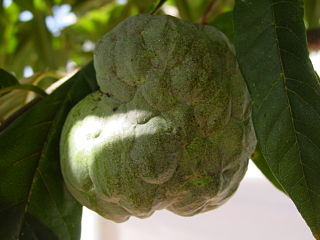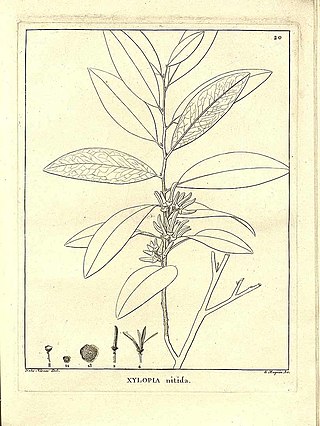
The Annonaceae are a family of flowering plants consisting of trees, shrubs, or rarely lianas commonly known as the custard apple family or soursop family. With 108 accepted genera and about 2400 known species, it is the largest family in the Magnoliales. Several genera produce edible fruit, most notably Annona, Anonidium, Asimina, Rollinia, and Uvaria. Its type genus is Annona. The family is concentrated in the tropics, with few species found in temperate regions. About 900 species are Neotropical, 450 are Afrotropical, and the remaining are Indomalayan.

Xylopia aethiopica is an evergreen, aromatic tree, of the Annonaceae family that can grow up to 20m high. It is a native to the lowland rainforest and moist fringe forests in the savanna zones of Africa.

Xylopia africana is a species of plant in the Annonaceae family. It is found in west-central Africa. It is restricted to submontane and lower montane forests. It is threatened due to habitat loss by clearance of forest. It was first described as Melodorum africanum in 1862 by George Bentham.
Xylopia amplexicaulis is a species of plant in the Annonaceae family. It is endemic to Mauritius. It is threatened by habitat loss.
Xylopia ekmanii is a species of plant in the Annonaceae family. It is endemic to Cuba.
Xylopia elliotii is a species of plant in the Annonaceae family. It is found in Ghana and possibly Ivory Coast.
Xylopia hastarum is a species of plant in the Annonaceae family. It is endemic to Jamaica. It is threatened by habitat loss.
Xylopia magna is a species of plant in the Annonaceae family. It is a tree found in Malaysia and Singapore.
Xylopia richardii is a species of plant in the Annonaceae family. It is found in Mauritius and Réunion. It is threatened by habitat loss.

Xylopia frutescens is a tree species the genus Xylopia and family Annonaceae and its native range is S. Mexico to S. Tropical America.

Xylopia brasiliensis, commonly known as pindaíba, is a species of plant in the family Annonaceae.

Xylopia aromatica is a species of plant in the Annonaceae family and the accepted name of Xylopia xylopioides.
Xylopia rubescens is a tree in the Annonaceae family, it grows up to 30 m tall. Usually found in a wide variety of wetland habitats in Tropical Africa, it is one of the more common of African species within its genus.
Xylopia densiflora is a species of plant in the Annonaceae family. It is native to Peru. Robert Elias Fries, the botanist who first formally described the species, named it after its dense clusters of flowers.

Xylopia nitida is a species of plant in the Annonaceae family. It is native to Brazil, Colombia, Ecuador French Guiana, Guyana, Suriname and Venezuela. Michel Félix Dunal, the botanist who first formally described the species, named it after the shiny upper surface of its leaves.
Xylopia calophylla is a species of plant in the Annonaceae family. It is native to Bolivia, Brazil, Colombia, Ecuador, Peru and Venezuela. Robert Elias Fries, the botanist who first formally described the species, named it after its beautiful leaves.
Xylopia micans is a species of plant in the Annonaceae family. It is native to Colombia, Ecuador and Peru. Robert Elias Fries, the botanist who first formally described the species, named it after the gleaming hairs on the undersides of its leaves.

Xylopia parviflora is a species of plant in the Annonaceae family. It is native to Bolivia, Brazil, Colombia, Ecuador, French Guiana, Peru and Venezuela. Richard Spruce, the botanist who first formally described the species, named it after its small flowers, though he did not specifically state their size.
Xylopia polyantha is a species of plant in the Annonaceae family. It is native to Bolivia, Brazil, Colombia, Ecuador, and Peru. Robert Elias Fries, the botanist who first formally described the species, named it after its many flowers.







